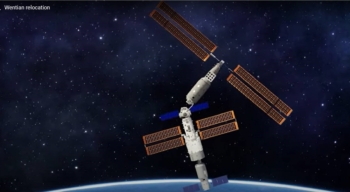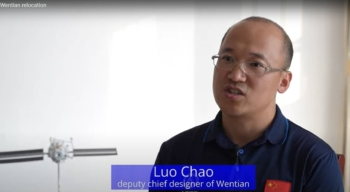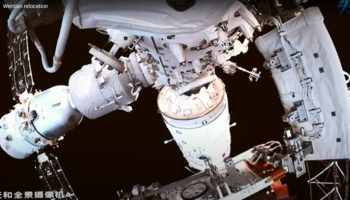
Credit: China National Space Administration (CNSA)/China Central Television (CCTV)/Inside Outer Space screengrab
China completed an in-orbit key step on Friday, Beijing Time – the transposition of the in-construction space station’s Wentian lab module.
The hour-long operation was carried out between astronauts inside the Tiangong orbital facility — Chen Dong, Liu Yang, and Cai Xuzhe — and ground controllers.
“After the Wentian lab module completed the transposition, the same techniques can be directly applied to Mengtian,” said Luo Chao, deputy chief designer of the Wentian lab module. “We describe the transposition as the most important part in the entire space station assembly and construction process, a hurdle that must be overcome,” he told China Central Television (CCTV).

Credit: China National Space Administration (CNSA)/China Central Television (CCTV)/Inside Outer Space screengrab
“In-orbit assembly and construction are like block building. Through docking and transposition technology, the block grows bigger and bigger, and whatever shape you want is possible,” added Yuan Huiling, chief designer of the sub-system of docking and transposition.
Ready for Mengtian module
The Wentian segment was launched in late July from the Wenchang Space Launch Center in south China’s Hainan Province and then connected with the Tianhe core module.
Wentian is 23-tons in weight and 59-feet (17.9-meters) in length. This module is presently the largest and heaviest spacecraft China has ever built and also the world’s heaviest self-propelled spaceship in service, according to CCTV.

Credit: China National Space Administration (CNSA)/China Central Television (CCTV)/Inside Outer Space screengrab
Next up is launch next month of the Mengtian module, Tiangong’s second lab component. Once Mengtian is connected to Tiangong, the station will be T-shaped and astronauts will have as much as 110 cubic meters of usable space.
Docking mechanism
Yuan also noted that completing the rendezvous and docking in space is like the collision of two large vehicles of dozens of tons. The greater the mass, the greater the kinetic energy generated. The kinetic energy can only be eliminated by the docking mechanism. The new generation of docking mechanism can quickly absorb and consume the released energy, he told CCTV.
“Capture requires high speed. If I want to catch you, I must increase the speed. But I can’t bump against you…I just wish the speed was as low as possible. The lower the speed, the lower the energy, which means it is easier to absorb. This is contradictory,” Yuan added. “Therefore, we put a lot of emphasis on the design of our docking mechanism. The docking mechanism is considered to be the most complex mechanism product in space. The sparrow may be small, fully-equipped.”

Credit: China National Space Administration (CNSA)/China Central Television (CCTV)/Inside Outer Space screengrab
The transposition mission was divided into three steps: the separation of Wentian from the core module, the translation of Wentian, as well as its docking with the core module’s flank and permanent berthing here.
L-shaped
To ensure that the hour-long operation went smoothly, astronauts inside the Tiangong space station and ground controllers in China made sure the space station assembly was lined up perpendicular to the Earth’s surface, with the craft’s solar panels being used throughout to ensure the module remained steady.

Station complete is set for year’s end.
Credit: CNSA/CCTV Video News Agency/Inside Outer Space screengrab
After the operation, the Tiangong station is now L-shaped and will remain in that shape until docking with the Mengtian lab module in October.
If all goes according to plan, the entire space station is to be completed by year’s end.
Go to these CCTV videos of the transposition maneuver of the module at:

